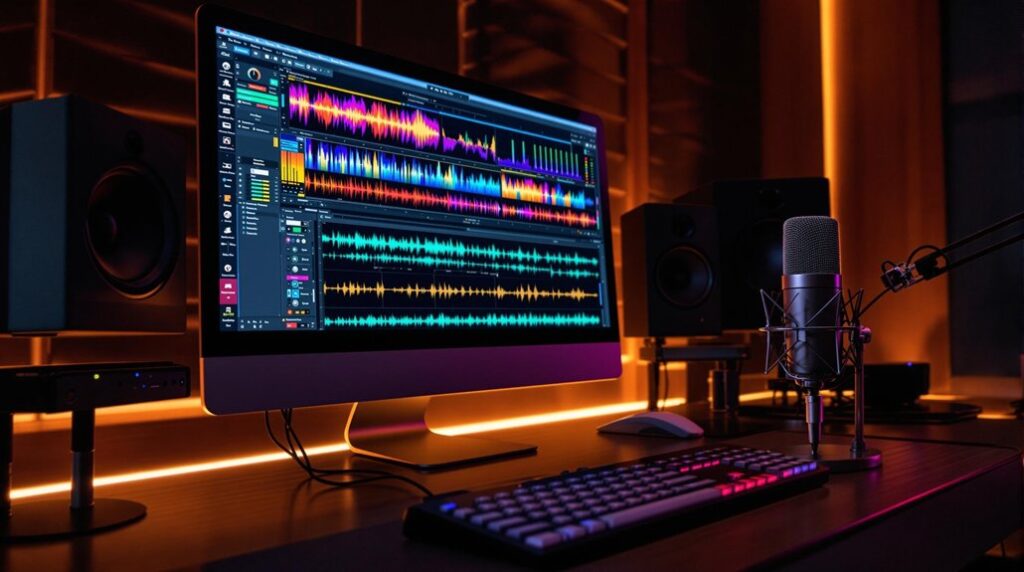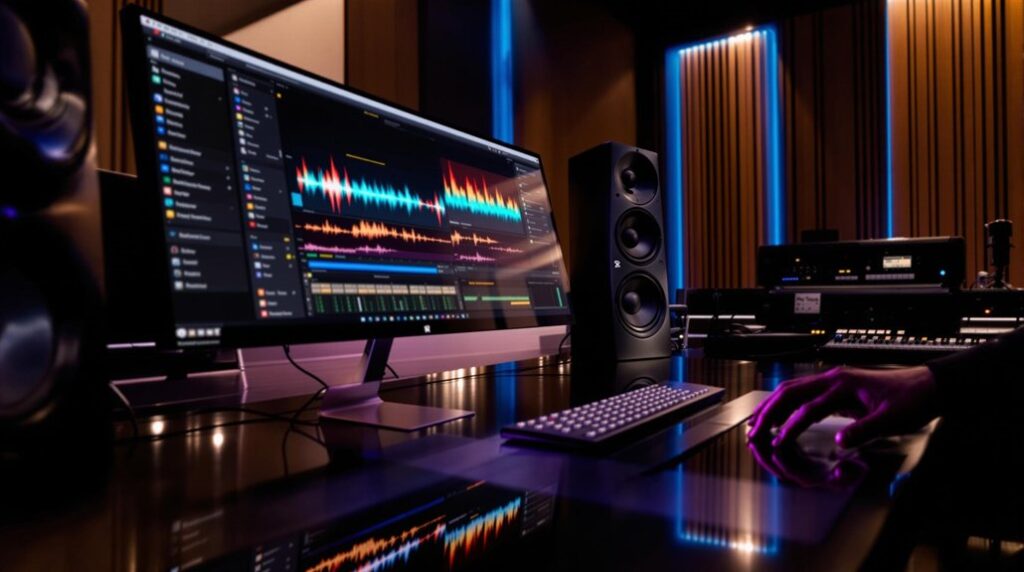To meet the demands of Pro Tools in 2025, advanced multi-core processors like Intel Core i9 or AMD Ryzen 9 are vital for optimizing performance. Integrating 32GB or more RAM is important for managing larger sessions. High-speed SSDs, particularly M.2 NVMe, greatly reduce latency. Superior audio interfaces such as Avid HDX guarantee low latency, while accurate monitoring systems enhance sound clarity. Versatile MIDI controllers streamline production workflows. Finally, extensive integration with AAX plugins and ARA 2 enriches editing efficiency. Together, these components form the backbone for a robust audio production setup, opening the door to more advanced insights.
Key Takeaways
- Advanced multi-core processors enhance Pro Tools performance, crucial for handling complex audio projects effectively.
- High RAM capacity, ideally 32GB or more, ensures efficient editing and mixing workflows.
- High-speed SSD storage reduces load times and improves system responsiveness for seamless audio production.
- Superior audio interfaces provide low latency, excellent sound fidelity, and support for complex recording sessions.
- AAX format and ARA 2 integration enhance plugin compatibility and streamline editing workflows.
Advanced Multi-Core Processors
As the digital audio environment continues to evolve, utilizing advanced multi-core processors becomes vital for optimizing Pro Tools performance in 2025. Processors like the Intel Core i9 and AMD Ryzen 9, renowned for their high clock speeds and core counts, are essential for handling complex audio projects efficiently. These advanced multi-core processors provide robust performance, important for tasks such as mixing, editing, and real-time processing of multiple plugins. Hyper-threading technology further enhances resource allocation and multitasking, necessary for demanding production workflows. The latest Intel Core Ultra processors offer superior single-threaded performance, ensuring responsive audio editing and playback. Emphasizing CPUs with eight or more cores greatly boosts Pro Tools' capabilities, facilitating seamless operation in intricate audio environments. The integration of Pro Tools Ultimate software is crucial for achieving full operational synergy, enhancing performance under demanding workloads.
Increased RAM Capacity
A substantial increase in RAM capacity is essential for optimizing Pro Tools performance as we approach 2025. With the evolution of digital audio workstations, the necessity for increased RAM capacity has become undeniable.
While 32GB of RAM is ideal for managing larger mix sessions, upgrading to 64GB provides enhanced cache size and system responsiveness, vital for complex, sample-heavy projects.
In addition, configurations allowing expansion up to 192GB now cater to high-demand environments, ensuring seamless operation with multiple plugins and virtual instruments. This high RAM capacity reduces sluggish playback, greatly elevating audio editing and mixing efficiency.
As Pro Tools continues to advance, investing in substantial RAM not only supports intricate workflows but also enhances overall system efficiency, meeting the intricate demands of modern production.
High-Speed SSD Storage
In the field of digital audio workstations, high-speed SSD storage emerges as a key component for optimizing Pro Tools systems by 2025.
Solid State Drives (SSDs) such as the Samsung 970 EVO Plus and important MX500 are integral, offering superior data transfer rates necessary for efficient Pro Tools workflow. Their rapid read/write speeds greatly outperform traditional HDDs, reducing load times and streamlining audio production processes.
The M.2 NVMe SSD configuration is particularly advantageous, minimizing latency and facilitating seamless audio track playback and recording. Furthermore, SSDs' lack of moving parts guarantees quiet operation, essential for undisturbed recording sessions.
A strategic storage setup with a primary 500GB or 1TB SSD for the OS and applications, plus a secondary SSD for audio files, is recommended.
Superior Audio Interfaces
While optimizing a Pro Tools setup, superior audio interfaces stand as indispensable components for achieving unparalleled sound quality and operational efficiency.
Avid HDX and Focusrite Clarett exemplify high-quality sound standards through low latency and high sample rates crucial for professional music production. These audio interfaces support multiple inputs and outputs, facilitating complex recording sessions with simultaneous instrument and microphone connectivity.
Remarkably, Avid's MTRX Studio offers seamless integration with Pro Tools, featuring remote preamp control and advanced routing, tailored for demanding studio environments.
Superior audio interfaces, endowed with premium D/A converters, enhance fidelity and dynamic range, capturing sound source nuances.
The selection of such interfaces dramatically influences Pro Tools' workflow, with MIDI connectivity, DSP processing, and digital I/O enhancing production efficacy.
Focusrite Scarlett 2i2 4th Gen, known for its exceptional preamps and user-friendly design, is a recommended choice for musicians looking for high-quality sound and reliable performance.
Accurate Monitoring Systems
Precision in monitoring systems is essential for achieving high-quality music production within Pro Tools environments. Accurate monitoring systems hinge on the synergy between high-quality studio monitors and an audio interface that supports high-resolution audio, ensuring pristine frequency response and tonal integrity.
Studio monitors with flat frequency response refine sonic details, enhancing spatial awareness significant for professional-grade mixing. Complementary to these monitors, high-quality headphones are indispensable for critical listening, revealing subtle mix nuances.
Moreover, sound isolation and room acoustics are important; untreated environments can skew audio perception, adversely affecting mix accuracy. Consequently, investing in superior sound isolation and optimizing room acoustics is imperative.
In addition, choosing microphones with low self-noise levels is crucial to capture subtle details effectively, as they enhance the accuracy of recordings.
Collectively, these elements forge an uncompromised auditory environment, fundamental for mastering the nuances of Pro Tools production.
Versatile MIDI Controllers
Achieving high-fidelity audio in Pro Tools necessitates not only precise monitoring but also the dynamic capabilities offered by versatile MIDI controllers.
These controllers enhance interaction with virtual instruments, enabling real-time parameter modulation and expressive performances vital for advanced music creation.
Selecting the ideal MIDI controller involves evaluating keybed action, pad sensitivity, rotary encoders, and fader functionality to align with specific musical styles.
Integration with Pro Tools guarantees seamless setup, facilitating control over software instruments and effects.
Advanced models offer drum pads and sliders, empowering complex performances and streamlined workflows.
MIDI automation techniques such as using Continuous Control (CC) messages allow for detailed parameter programming, which is essential for nuanced sound shaping and dynamic audio production workflows.
Comprehensive Software Integration
The 2025 iteration of Pro Tools exemplifies thorough software integration by offering extensive support for AAX plugins, ensuring seamless compatibility with third-party effects and virtual instruments, thereby expanding the creative potential in music production. Enhanced workflow efficiency is achieved through built-in compatibility with MIDI controllers, enabling real-time interaction and streamlined operations. In addition, advanced features like Dolby Atmos support and cloud-based collaboration tools, such as Dropbox Replay, facilitate modern sound design and remote project management, solidifying Pro Tools 2025 as a pivotal tool in contemporary audio production environments. The integration of complex signal chains in Pro Tools 2025 allows for high plugin counts without degrading audio quality, offering professionals the flexibility needed for intricate audio projects.
Seamless Plugin Compatibility
In the field of digital audio workstations, seamless plugin compatibility stands as a pivotal feature for Pro Tools, facilitating thorough software integration.
Pro Tools' support for a wide array of plugins, particularly the AAX format, guarantees seamless interoperability with third-party audio processing tools and virtual instruments. This compatibility extends to over 120 powerful plugins, enhancing creative capabilities in mixing and mastering.
Extensive documentation, including guides for PlayCell, GrooveCell, and SynthCell, provides critical insights for effective usage and troubleshooting.
With ARA 2 integration, Pro Tools greatly streamlines editing workflows, allowing intuitive interactions between audio and MIDI applications.
Regular updates further enhance plugin performance and compatibility, guaranteeing users consistently access the latest features and improvements for a superior production experience.
Efficient Workflow Tools
Numerous innovations in Pro Tools are advancing efficient workflow tools through extensive software integration, thereby transforming music production paradigms.
Avid Pro Tools' seamless interfacing with third-party plugins and virtual instruments releases unprecedented creative potential, facilitating a diversified sonic palette. Key features such as audio track to MIDI conversion and thorough sound libraries augment user capabilities by optimizing creative processes.
The introduction of the Sketch window and iPad app streamlines idea generation, while drag-and-drop functionality inherently supports real-time arrangement experimentation. Solid State Drives guarantee rapid data access, enhancing system responsiveness.
In addition, integration with platforms like Dropbox Replay and AvidPlay promotes seamless collaboration and efficient music distribution, respectively, assuring that artists maintain control over their rights and earnings within the Pro Tools ecosystem.
Frequently Asked Questions
What Are the Requirements for Pro Tools?
Pro Tools compatibility necessitates updated operating systems like Windows 10/11, ensuring seamless software updates. Ideal system performance demands robust audio interfaces, appropriate processor power, and ample RAM, with solid state drives enhancing read/write efficiency for professional-grade audio production.
Has Avid Officially Discontinued Pro Tools?
Avid has not officially discontinued Pro Tools; instead, it continues to release Avid updates, enhancing Pro Tools features. The user community remains engaged, with software compatibility maintained, ensuring Pro Tools remains competitive amidst industry alternatives.
How Much RAM Do You Need for Pro Tools?
For ideal Pro Tools performance, RAM upgrades to at least 32GB are recommended for effective memory management and system compatibility. Higher capacities enhance audio processing and performance optimization, especially in complex sessions requiring efficient multitasking and resource allocation.
Which Mac for Pro Tools 2024?
Choosing a Mac for Pro Tools 2024 necessitates careful consideration of Mac compatibility, emphasizing Pro Tools performance. Opt for M1/M2 chips over Intel for future upgrades. Evaluate high-quality audio interface options to enhance recording and playback efficiency.
Conclusion
To summarize, the evolution of pro tools by 2025 necessitates a strategic alignment with advancements in multi-core processors, expanded RAM capacity, and high-speed SSD storage to enhance computational efficiency. Superior audio interfaces and accurate monitoring systems are imperative for improved sound fidelity, while versatile MIDI controllers offer essential adaptability for diverse production needs. Extensive software integration remains critical, ensuring seamless interoperability across platforms. These elements collectively underscore the industry's trajectory towards more efficient, high-performance audio production environments.




